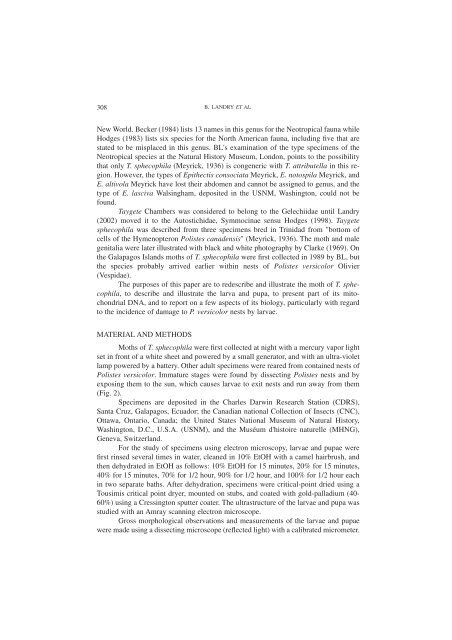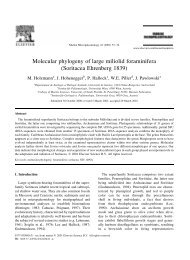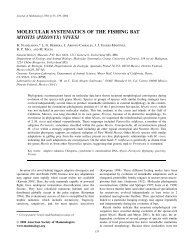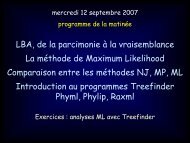Landry et al. 2006.pdf - Webspace
Landry et al. 2006.pdf - Webspace
Landry et al. 2006.pdf - Webspace
Create successful ePaper yourself
Turn your PDF publications into a flip-book with our unique Google optimized e-Paper software.
308B. LANDRY ET AL.New World. Becker (1984) lists 13 names in this genus for the Neotropic<strong>al</strong> fauna whileHodges (1983) lists six species for the North American fauna, including five that arestated to be misplaced in this genus. BL's examination of the type specimens of theNeotropic<strong>al</strong> species at the Natur<strong>al</strong> History Museum, London, points to the possibilitythat only T. sphecophila (Meyrick, 1936) is congeneric with T. attributella in this region.However, the types of Epithectis consociata Meyrick, E. notospila Meyrick, andE. <strong>al</strong>tivola Meyrick have lost their abdomen and cannot be assigned to genus, and th<strong>et</strong>ype of E. lasciva W<strong>al</strong>singham, deposited in the USNM, Washington, could not befound.Tayg<strong>et</strong>e Chambers was considered to belong to the Gelechiidae until <strong>Landry</strong>(2002) moved it to the Autostichidae, Symmocinae sensu Hodges (1998). Tayg<strong>et</strong>esphecophila was described from three specimens bred in Trinidad from "bottom ofcells of the Hymenopteron Polistes canadensis" (Meyrick, 1936). The moth and m<strong>al</strong>egenit<strong>al</strong>ia were later illustrated with black and white photography by Clarke (1969). Onthe G<strong>al</strong>apagos Islands moths of T. sphecophila were first collected in 1989 by BL, butthe species probably arrived earlier within nests of Polistes versicolor Olivier(Vespidae).The purposes of this paper are to redescribe and illustrate the moth of T. sphecophila,to describe and illustrate the larva and pupa, to present part of its mitochondri<strong>al</strong>DNA, and to report on a few aspects of its biology, particularly with regardto the incidence of damage to P. versicolor nests by larvae.MATERIAL AND METHODSMoths of T. sphecophila were first collected at night with a mercury vapor lights<strong>et</strong> in front of a white she<strong>et</strong> and powered by a sm<strong>al</strong>l generator, and with an ultra-viol<strong>et</strong>lamp powered by a battery. Other adult specimens were reared from contained nests ofPolistes versicolor. Immature stages were found by dissecting Polistes nests and byexposing them to the sun, which causes larvae to exit nests and run away from them(Fig. 2).Specimens are deposited in the Charles Darwin Research Station (CDRS),Santa Cruz, G<strong>al</strong>apagos, Ecuador; the Canadian nation<strong>al</strong> Collection of Insects (CNC),Ottawa, Ontario, Canada; the United States Nation<strong>al</strong> Museum of Natur<strong>al</strong> History,Washington, D.C., U.S.A. (USNM), and the Muséum d'histoire naturelle (MHNG),Geneva, Switzerland.For the study of specimens using electron microscopy, larvae and pupae werefirst rinsed sever<strong>al</strong> times in water, cleaned in 10% EtOH with a camel hairbrush, andthen dehydrated in EtOH as follows: 10% EtOH for 15 minutes, 20% for 15 minutes,40% for 15 minutes, 70% for 1/2 hour, 90% for 1/2 hour, and 100% for 1/2 hour eachin two separate baths. After dehydration, specimens were critic<strong>al</strong>-point dried using aTousimis critic<strong>al</strong> point dryer, mounted on stubs, and coated with gold-p<strong>al</strong>ladium (40-60%) using a Cressington sputter coater. The ultrastructure of the larvae and pupa wasstudied with an Amray scanning electron microscope.Gross morphologic<strong>al</strong> observations and measurements of the larvae and pupaewere made using a dissecting microscope (reflected light) with a c<strong>al</strong>ibrated microm<strong>et</strong>er.






